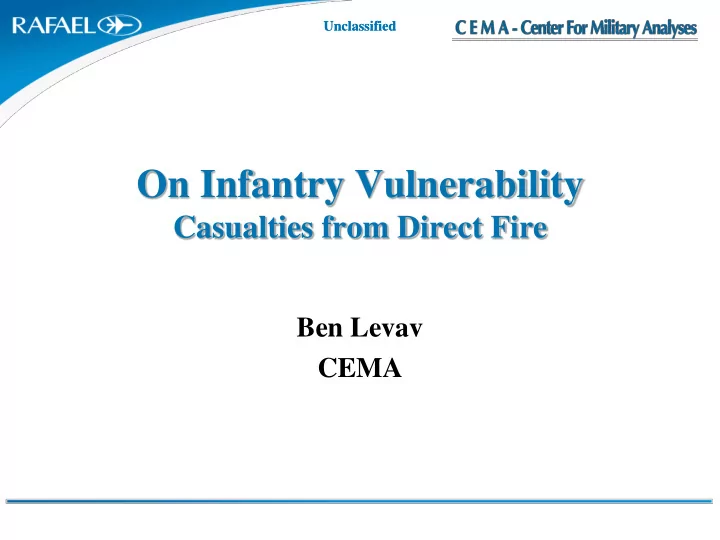

Unclassified Unclassified On Infantry Vulnerability Casualties from Direct Fire Ben Levav CEMA
Unclassified Objective Formulating a descriptive mathematical model for assessing casualty rates in an Infantry attack 2
Unclassified Scope This study assess casualty rates, in an infantry attack on an unfortified stronghold garrisoned by infantry soldiers as well, caused by two types of fire that can be applied on the battlefield: • Indirect fire, i.e. artillery of different types • Direct fire For the purpose of this study direct fire is defined as fire from personal assault weapons that require a direct line of sight for engaging targets 3
Unclassified Method Overview Formulating a descriptive model for describing a generic infantry attack Modeling the connections between activities Analysis - Applying to chosen scenarios as part of the general methodology 4
Unclassified The Generic Attack Model Moving from Organizing in applying applying applying assembly support-by- Cover fire Cover fire Cover fire area fire position Organizing Movement Charging Next in Assault towards Breaching the objectives position breaching objective Applying Applying Applying direct fire direct fire direct fire Applying Applying Applying Applying indirect indirect indirect indirect fire fire fire fire Surveillance Surveillance Surveillance Surveillance Priority connector for detecting for detecting for detecting for detecting Sync. connector the attacker the attacker the attacker the attacker Influence connector 5
Unclassified Charging On The Objective Support force applying Cover fire Fire and Attack force Charge movement Applying Applying Defense force direct fire direct fire 6
Unclassified Model Assumptions The basic infantry unit is the Buddy team , it can be engaged in only one of the activities above at a given time The fighting of a team or a squad can be described by the fighting of it’s Buddy teams The battlefield is dynamic and includes several forces the activities of one side influence the other (casualties, movement times etc) 7
Unclassified Method Overview Building a descriptive model for describing a generic infantry attack Modeling the connections between the activities in the model Applying to chosen scenarios as part of the general methodology 8
Unclassified Modeling the Influence Connections These connections exist between different activities infantry soldiers can be engaged in during combat Couples of Activities Fire from a Movement Charge fire position - Feasible Charge - Unfeasible/ Movement Unlikely Fire from a fire position The activity couples are modules , they are described using flow charts 9
Unclassified The activity couples are constructed from sub-activities which are “Functions” described using mathematical tools 10
Unclassified Demonstration of Selected Functions Firing - computing the hit probabilities Objective clearing 11
Unclassified Method Overview Building a descriptive model for describing a generic infantry attack Modeling the connections between the activities in the model Applying to chosen scenarios as part of the general methodology - Demonstration 12
Unclassified Applying the Model - Demonstration A given scenario – a platoon attack on an objective divided into three smaller objective each defended by an enemy fire team 13
Unclassified 1 st 3 rd 2 nd 14
Unclassified 2 nd 1 st 3 rd 15
Unclassified 3 rd 2 nd 1 st 16
Unclassified Applying the Model – Demonstration cont. “Breaking” the scenario into Buddy teams combat: • 3 squads offensives = 12 buddy teams combats • Range to objective from assault position = 200 meters • Fire rate • … 17
Unclassified Applying the Model – Demonstration cont. Describing each attack (the connections between the sides) using the modules: Stage of the attack Attacking Buddy Cover fire soldier Defender team Movement / Firing Firing from a fire Firing from a Moving and firing from a fire position position fire position Charging the Firing from a Charge ----- objective fire position Using Monte-Carlo simulations to describe the scenario (MATLAB) Extracting the distribution of the casualties from the simulations 18
Unclassified The Distribution of Casualties 19
Unclassified The Distribution of Casualties Enhancement of Cover Fire Effectiveness 20
Unclassified The Distribution of Casualties Data Fitting 21
Unclassified Concluding Remarks On Infantry Vulnerability Is one of the building blocks of the methodology for comparing force configurations based on operational efficiency The model gives a thorough description of infantry combats and supply mathematical tools for assessing different parameters The generic modules presented in the study can be used to describe a variety of scenarios and can be used to evaluate different offered tactics or abilities and their influence 22
Unclassified Thank you! 23
Recommend
More recommend